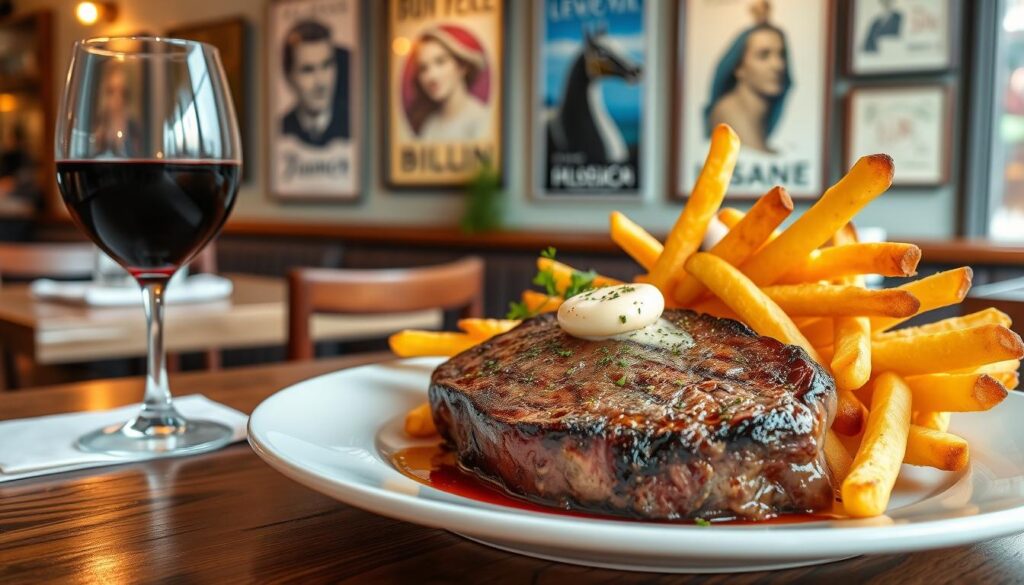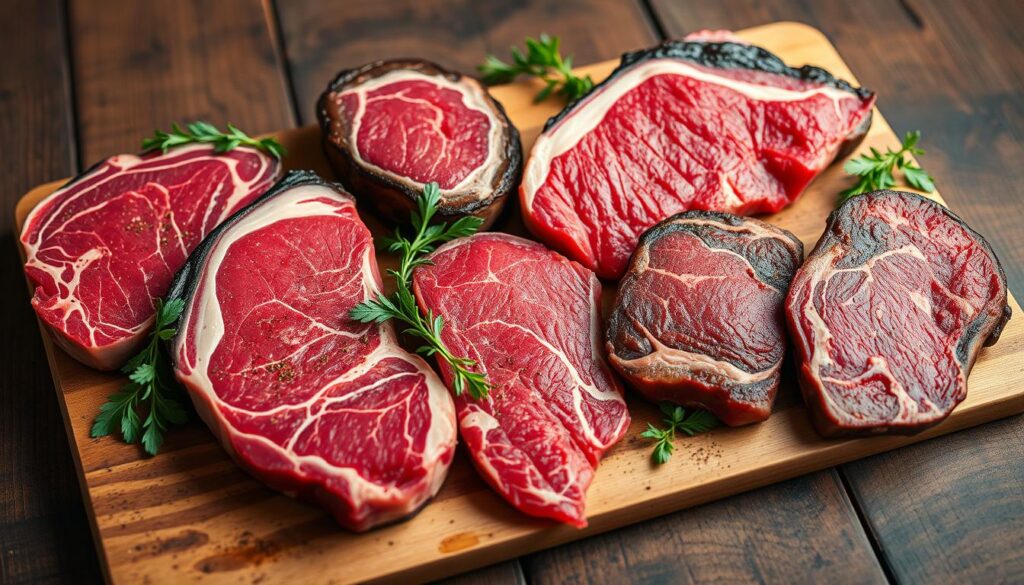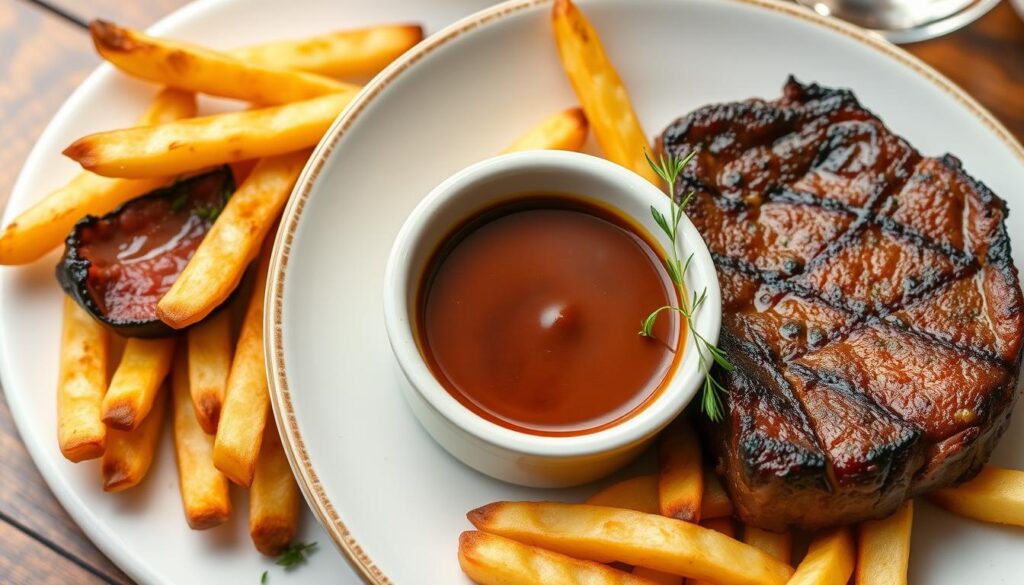The first time I saw a chef make steak frites sauce in Paris, it was magical. The sizzle of the ribeye and the whisking of béarnaise sauce turned a simple meal into something special. It changed how I see cooking forever.
Steak frites is more than a dish. It’s a French tradition that brings together steak, crispy fries, and a rich sauce. Whether you cook at home or dream of being a chef, learning this classic will open a world of flavors.
This guide will show you how to make steak frites like a pro. You’ll learn about choosing the right meat and making the perfect béarnaise sauce. Follow these steps to impress anyone with your cooking.
Key Takeaways
- Understand the essential techniques of French bistro cooking
- Learn how to prepare authentic béarnaise sauce
- Master steak cooking temperatures for perfect doneness
- Discover the art of creating crispy, golden french fries
- Transform your home cooking with professional techniques
Understanding the Classic French Steak Frites Tradition

French cuisine is all about simple yet amazing meals. Steak frites is a top favorite in bistros. It’s more than food; it’s a way to experience French cooking at its best.
Steak preparation in French restaurants is an art. Chefs pick cuts that are full of flavor and texture. They often choose less tender cuts like:
- Onglet (hanger steak)
- Tri-tip
- Rump steak
- Flank steak
Origins of the Culinary Classic
Steak frites comes from France’s lively bistro scene. It’s all about simple, high-quality ingredients. The dish is a perfect mix of tender steak and crispy fries.
Traditional Bistro Preparation Methods
French bistro chefs are very precise with steak. They follow a detailed process that includes:
- Bringing the steak to room temperature
- Seasoning with salt and pepper
- Searing at high heat for a great crust
- Resting the meat to keep juices in
Essential Components of Authentic Steak Frites
Making real steak frites needs focus on every detail. From choosing the best ribeye to mastering fry technique, each part is important. The goal is to balance the steak’s rich taste with the fries’ crunchy texture.
Selecting the Perfect Cut of Steak for Your Dish

Choosing the right steak is key for a great Steak Frites. French bistros pick specific cuts for their flavor and tenderness. Your choice can make the dish.
- Entrecôte: A ribeye equivalent with rich marbling
- Romsteck: Similar to sirloin, lean and flavorful
- Faux-filet: Comparable to New York strip steak
- Bifteck: A general term for quality beef cuts
In American kitchens, top cuts are:
- Ribeye: Very juicy with lots of fat marbling
- Sirloin: Leaner but full of beef flavor
- Filet mignon: The tenderest cut, great for precise cooking
Choose steaks that are 3/4 to 1 inch thick. This size is perfect for searing and staying juicy inside. The thickness affects cooking time and method, sometimes needing oven finishing for thicker steaks.
Pro tip: Always pick well-aged steaks for tenderness and deep flavor. Your choice of cut will make your Steak Frites amazing.
The Ultimate Steak Frites Sauce Recipe
Making the perfect béarnaise sauce turns a simple steak frites into a gourmet dish. This French sauce adds a rich, creamy touch and a complex taste. It makes your meal special.
Classic Béarnaise Sauce Preparation
To start, pick the best ingredients. You’ll need top-notch white wine vinegar, fresh tarragon, shallots, and egg yolks. The secret to a smooth sauce is in the technique and keeping the right temperature.
- Finely chop fresh tarragon leaves
- Select premium white wine vinegar
- Use room temperature egg yolks
- Prepare unsalted butter for incorporation
Wine and Herb Reduction Techniques
First, make a flavorful reduction. Mix white wine vinegar, minced shallots, and tarragon. Let it simmer until it’s reduced by two-thirds. This step makes the sauce rich with herb flavors.
Temperature Control and Timing Tips
Getting béarnaise sauce right takes time. Whisk egg yolks slowly over low heat, adding melted butter bit by bit. Keep an eye on the temperature. If it’s too hot, the sauce will break. If it’s too cold, it won’t thicken right.
- Maintain low, consistent heat
- Whisk continuously
- Add butter in small increments
- Serve warm for best flavor
Pro tip: The sauce can be gently reheated if prepared in advance, but avoid high temperatures that can cause separation.
Mastering the Perfect French Fry Technique
Making the ultimate crispy fries, or pommes frites, needs precision and skill. Your journey starts with picking the right potatoes. Then, you learn the cooking steps that turn simple ingredients into top-notch crispy fries.
For perfect pommes frites, follow these essential steps:
- Choose russet potatoes for the best texture
- Cut potatoes into uniform thin strips
- Soak potato strips in cold water for 15-30 minutes to remove excess starch
- Pat potatoes completely dry before frying
The secret to crispy fries is the double-frying method. First, fry at a lower temperature of 250-325°F. This cooks the potato inside. Then, increase the oil temperature to 375°F for the second fry. This step makes the fries golden and crisp, making them irresistible.
To make your French fry preparation even better, try these flavor variations:
- Garlic Parmesan frites
- Truffle-seasoned crispy fries
- Sweet potato alternative
Pro tip: Use a deep-frying thermometer to keep the oil temperature steady. This ensures perfectly crispy pommes frites every time.
Essential Equipment and Ingredients
Making the perfect Steak Frites is more than just skill. Your kitchen tools and the quality of your ingredients are key. They turn a simple meal into a French culinary masterpiece.
Professional Kitchen Tools Required
Choosing the right kitchen equipment is vital for Steak Frites. You’ll need:
- Heavy-duty cast-iron skillet for perfect steak searing
- Stainless steel saucepan for béarnaise sauce
- Reliable deep fryer or flat cooktop for crispy fries
- Sharp chef’s knife for precise ingredient preparation
- Instant-read meat thermometer for accurate cooking
Quality Ingredients Checklist
The quality of your ingredients greatly affects your dish’s taste. Choose the best:
- Steak: 2 (12-ounce) boneless ribeye, preferably grass-fed
- Fresh herbs: tarragon, thyme, rosemary
- High-quality white wine vinegar
- Unsalted European-style butter
- Fresh organic eggs for sauce
Storage and Preparation Tips
Storing and preparing your ingredients properly is key. Keep fresh ingredients in sealed containers. Store herbs in the fridge and butter wrapped tightly. Let steak come to room temperature 30 minutes before cooking for even heat.
Pro tip: Make béarnaise sauce ingredients ahead of time. This lets flavors mix and makes cooking easier. With the right tools and ingredients, your Steak Frites will be amazing.
Professional Cooking Techniques for Restaurant-Quality Results
To make steak frites like a pro, you need to master certain searing techniques. These methods turn a simple meal into a gourmet experience. Chefs know that controlling the temperature is key to getting a steak that’s both golden outside and juicy inside.
Here are some essential techniques for cooking steak like a pro:
- Choose a cut like ribeye for the best flavor
- Let the steak warm up to room temperature before cooking
- Use high heat for the initial sear
- Keep an eye on the internal temperature
The sauce is also important for a great steak frites. Chefs suggest using a double boiler to avoid curdling. The sauce should be thick enough to coat the back of a spoon but not too thick.
For searing, chefs use different heat zones. First, sear the steak at high heat (around 450°F) for 3-4 minutes on each side. This creates a rich, caramelized crust. Then, move it to a cooler zone to finish cooking, ensuring it’s cooked to your liking.
- Shoot for medium-rare at 130°F-135°F internal temperature
- Let the steak rest for 5-10 minutes after cooking
- Use a meat thermometer for exactness
By using these professional techniques, you can make your steak frites at home taste like it’s from a restaurant. It will impress anyone who tries it.
Pairing Your Steak Frites with Classic French Sides
Improving your steak frites experience is more than just cooking it right. The right wine and French side dishes can make your meal unforgettable. These choices enhance your steak’s flavors, taking your meal to the next level.
Wine Pairing Suggestions
Finding the perfect wine can elevate your steak frites. A bold Cabernet Sauvignon pairs well with red meat, adding depth to the flavor. For a special touch, try a crisp Champagne. It’s light and elegant, balancing the dish’s richness.
- Cabernet Sauvignon: Perfect for red meat
- Champagne: Light and celebratory option
- Pinot Noir: Lighter red wine alternative
Complementary French Side Dishes
Traditional French sides can make your steak frites feel like a fancy restaurant meal. A simple salade verte with a light vinaigrette is a refreshing contrast. Grilled asparagus or roasted veggies add nutrition and flavor.
Elegant Garnishes
Garnishes are the key to a memorable dish. Sprinkle fresh parsley on your frites for color and taste. A pat of herb-infused butter on your steak adds a luxurious touch.
- Fresh parsley for frites
- Herb-infused butter for steak
- Lemon zest for brightness
Finish your meal with a classic French dessert like crème brûlée or chocolate mousse. It’s a sweet way to end your culinary adventure.
Troubleshooting Common Sauce Problems
Getting the right sauce consistency can be tough, even for pros. Knowing how to rescue a sauce can turn a mess into a masterpiece. Learning about emulsion techniques helps fix common sauce problems fast.
If your sauce starts to break, stay calm. Here are some ways to save your sauce:
- For a curdling béarnaise, use a double boiler method to maintain gentle heat
- Whisk in a small amount of cold water if the sauce separates
- Gradually add warm water for overly thick sauces
- Continue reducing for thin sauces to achieve desired consistency
Temperature control is key in making sauces. Slow and steady wins the race when working with delicate emulsions. Keep whisking and heat moderate to avoid breaking.
Professional chefs share these tips for perfect sauce consistency:
- Always add liquids incrementally
- Use room temperature ingredients
- Whisk continuously during sauce preparation
- Remove from heat promptly to prevent overcooking
With practice, you’ll get better at saving and perfecting your sauces every time.
Variations on Classic Steak Frites Sauce
Exploring different sauces can make steak frites even better. It brings new flavors from around the world to your table. Chefs have come up with fresh ways to mix the classic steak and fries.
Modern Culinary Interpretations
Today’s chefs are trying new things with steak frites sauce. They’re mixing up flavors to make your dish more exciting:
- Truffle-infused sauces with earthy undertones
- Garlic-parmesan cream sauce for rich complexity
- Spicy chimichurri-inspired herb blends
- Coconut curry sauce for an unexpected twist
Regional French Flavor Explorations
France’s different areas have their own steak frites sauce styles. Each place uses local ingredients and cooking methods for unique tastes:
- Provence-style herbed butter sauce
- Burgundy wine reduction with shallots
- Normandy cream-based sauces
- Alpine herb-infused preparations
By trying these sauces, you can make steak frites your own. It’s all about mixing old ways with new ideas.
Conclusion
Embracing the French culinary tradition makes your home cooking special. Learning to make steak frites takes practice and passion. You’ll learn about temperature, sauce making, and choosing the right ingredients.
Creating French bistro dishes at home is all about the details. Cook your steak to 130°F for medium-rare and let it rest for 5-10 minutes. Making Béarnaise sauce or trying new sauces like peppercorn will improve your skills and wow your guests.
Every try at making steak frites brings you closer to being a pro. Whether you’re searing a steak or using herb butter, your dedication will show. Steak frites is more than food; it’s a celebration of cooking that connects you to a rich tradition.
Great cooking is about always learning and enjoying the journey. Your kitchen becomes a place where French techniques and your creativity come together. This turns a simple meal into a memorable experience.

